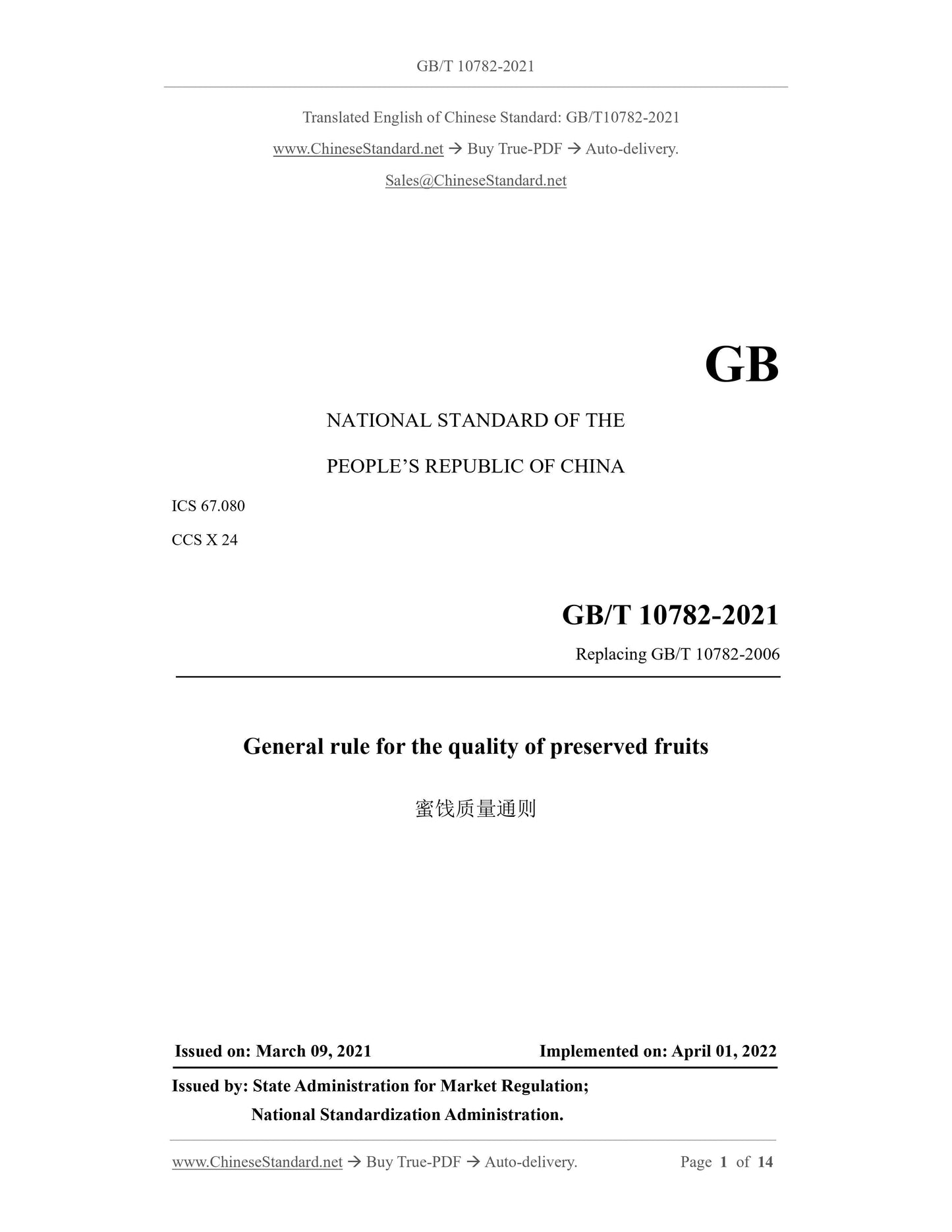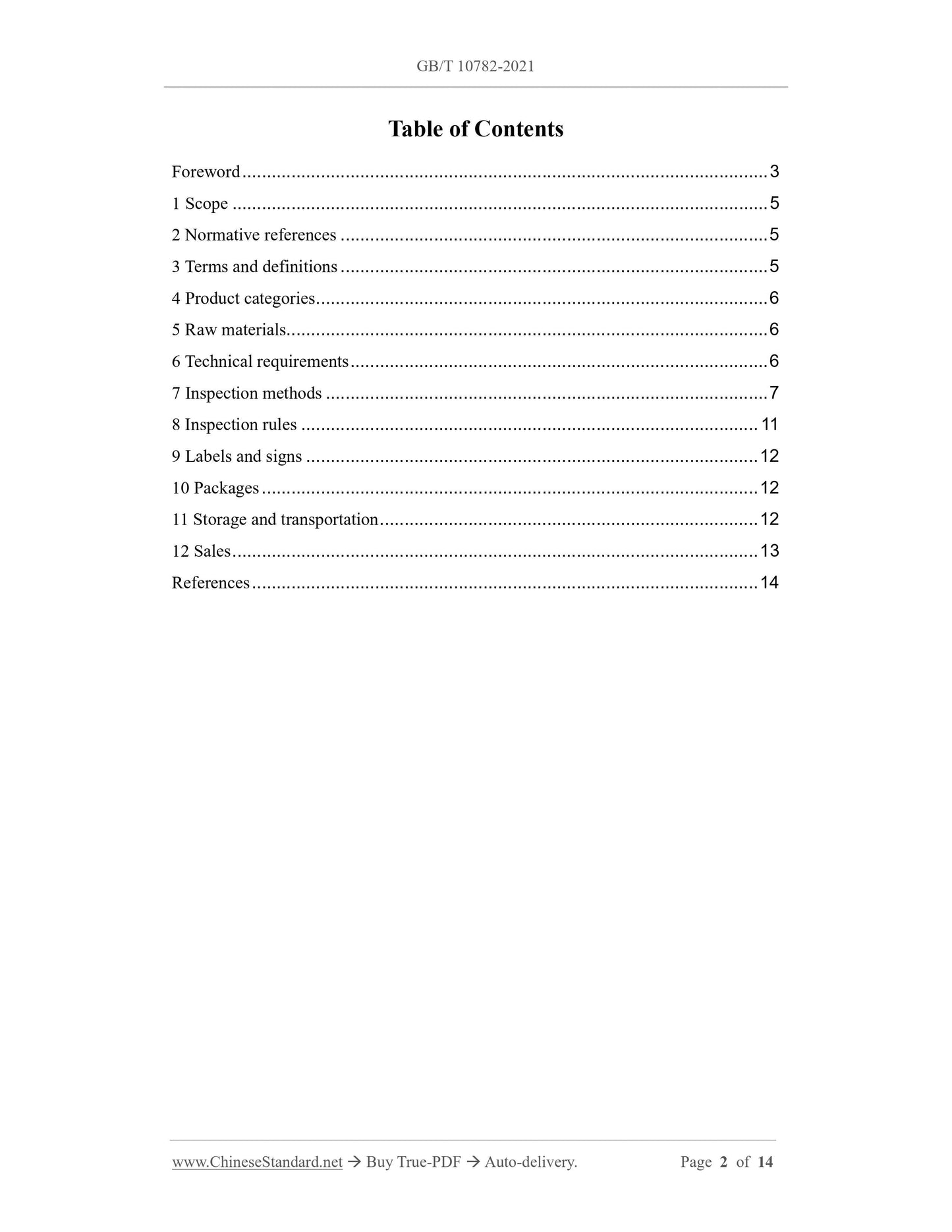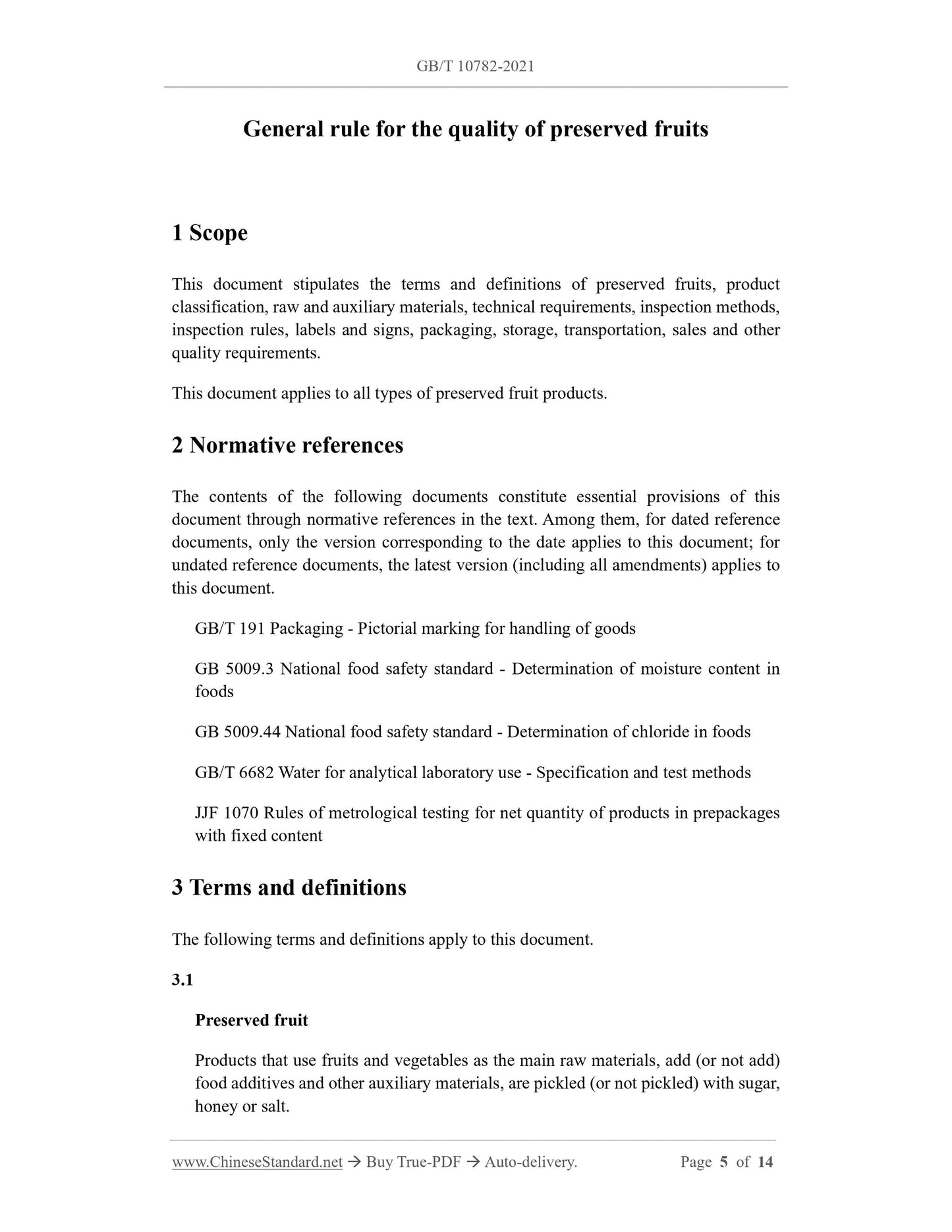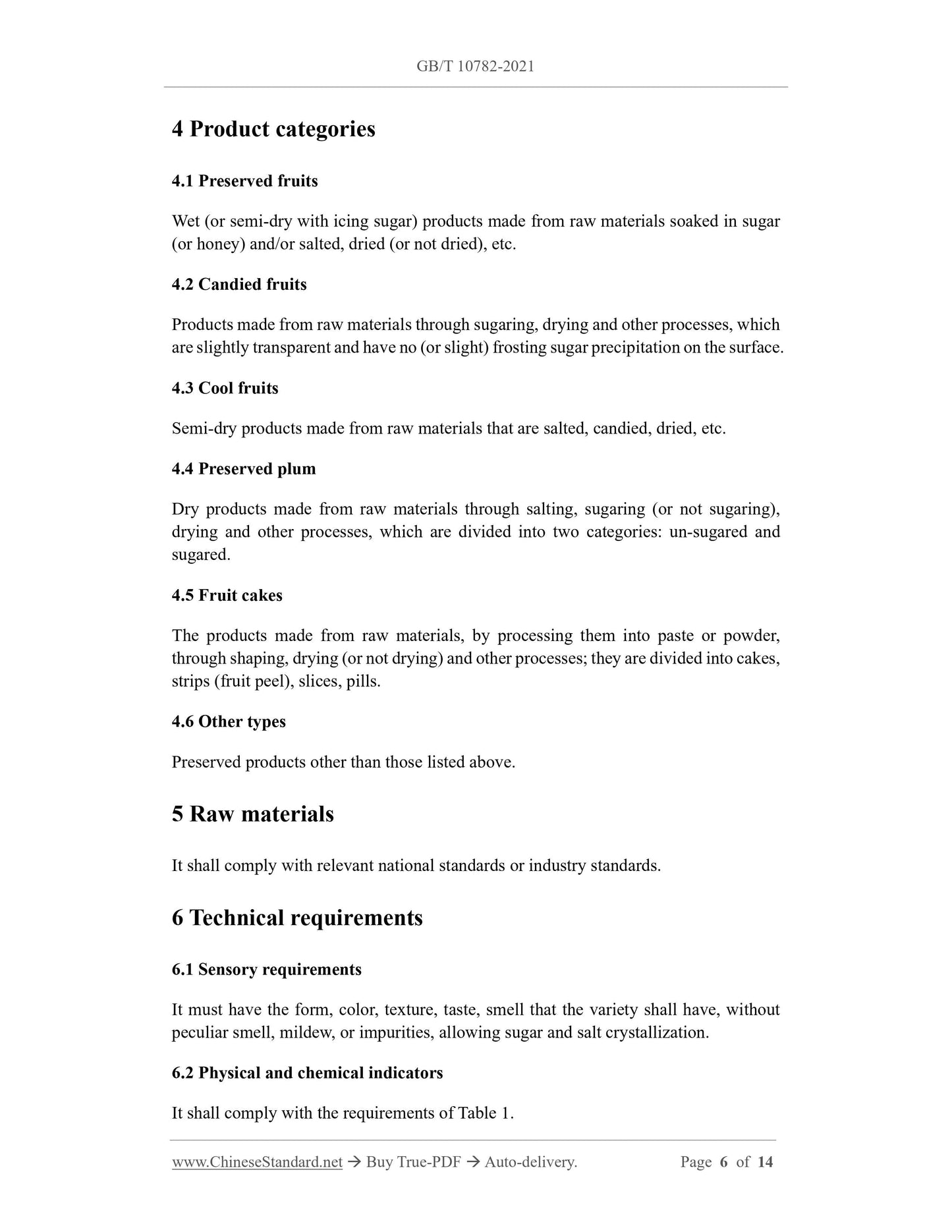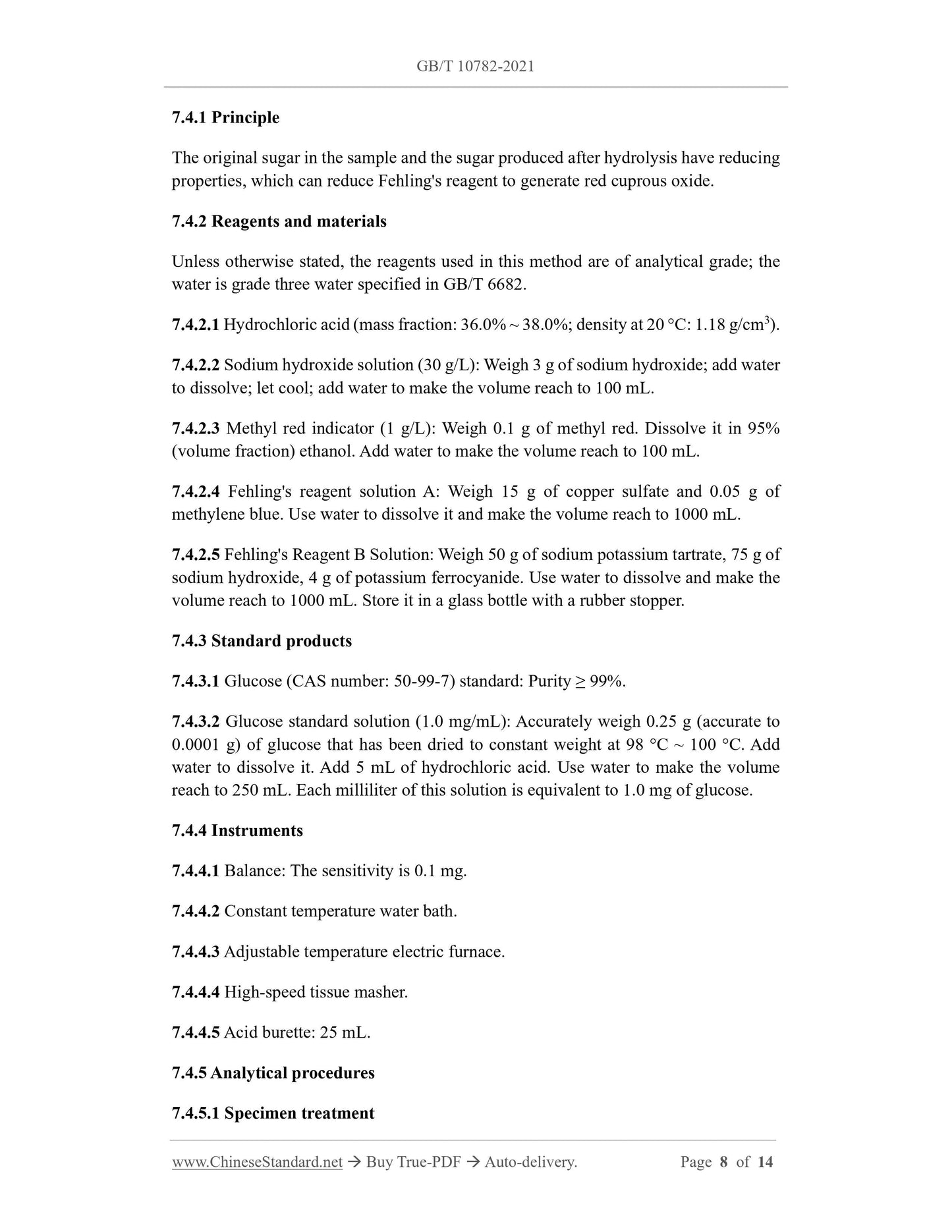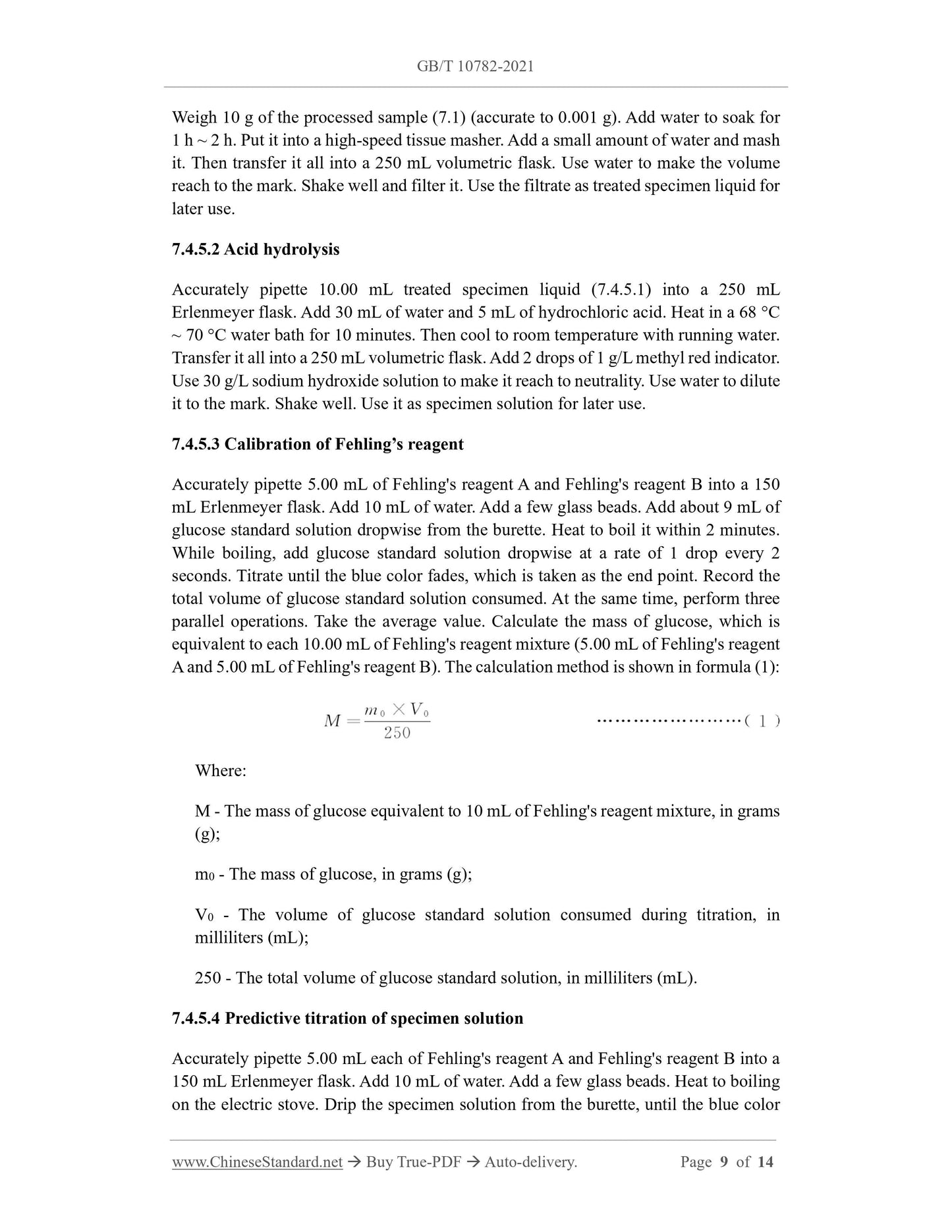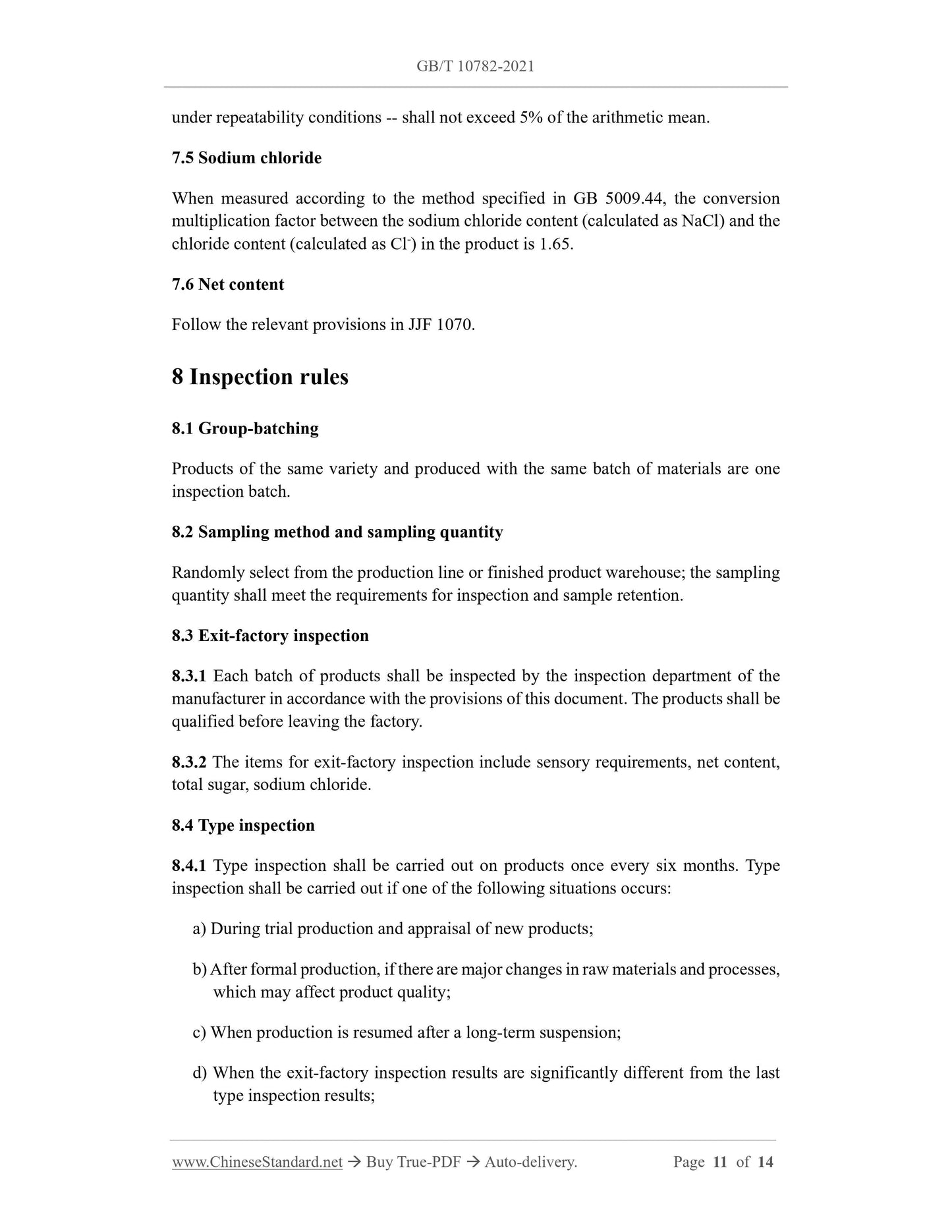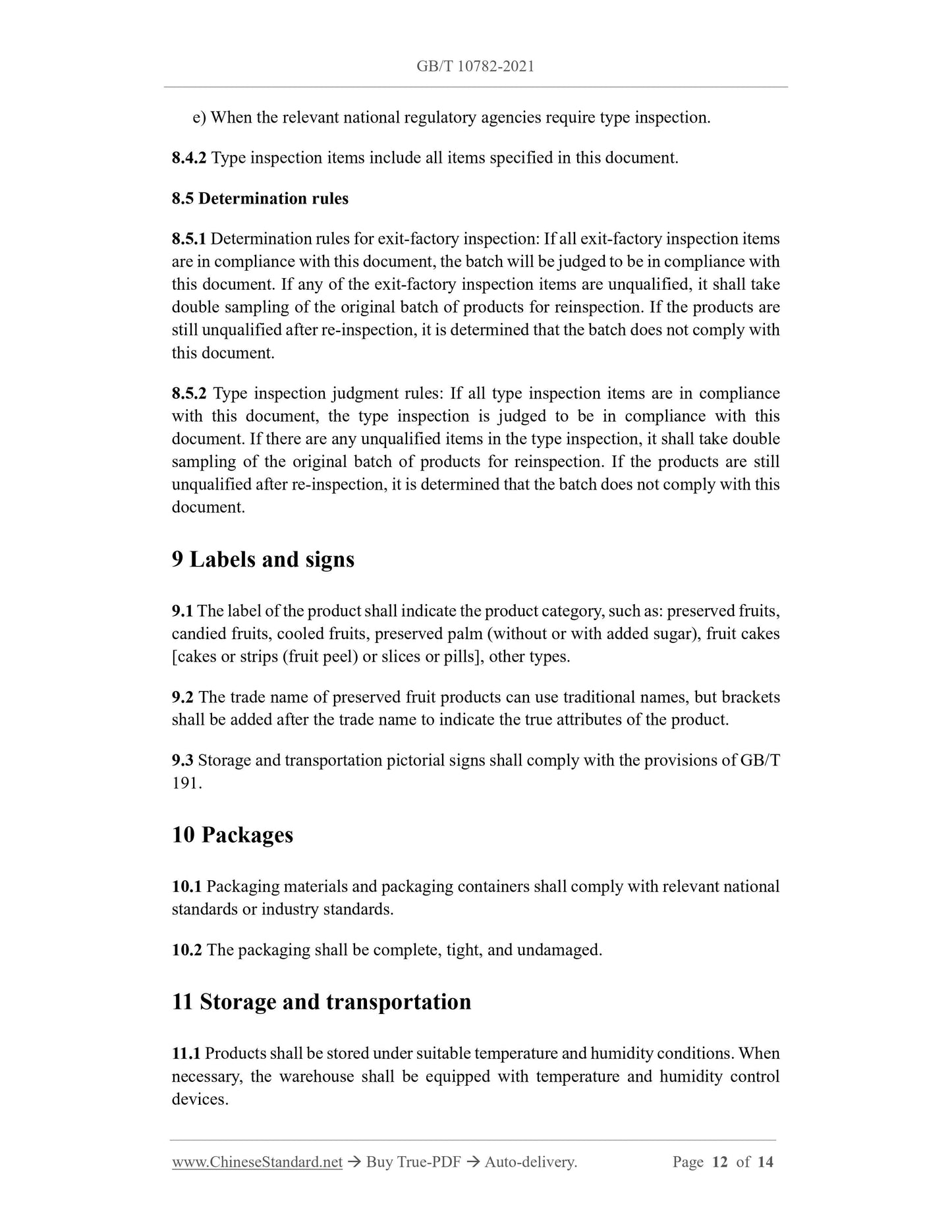1
/
of
8
www.ChineseStandard.us -- Field Test Asia Pte. Ltd.
GB/T 10782-2021 English PDF (GB/T10782-2021)
GB/T 10782-2021 English PDF (GB/T10782-2021)
Regular price
$170.00
Regular price
Sale price
$170.00
Unit price
/
per
Shipping calculated at checkout.
Couldn't load pickup availability
GB/T 10782-2021: General rule for the quality of preserved fruits
Delivery: 9 seconds. Download (& Email) true-PDF + Invoice.
Get Quotation: Click GB/T 10782-2021 (Self-service in 1-minute)
Historical versions (Master-website): GB/T 10782-2021
Preview True-PDF (Reload/Scroll-down if blank)
GB/T 10782-2021
GB
NATIONAL STANDARD OF THE
PEOPLE’S REPUBLIC OF CHINA
ICS 67.080
CCS X 24
Replacing GB/T 10782-2006
General rule for the quality of preserved fruits
ISSUED ON: MARCH 09, 2021
IMPLEMENTED ON: APRIL 01, 2022
Issued by: State Administration for Market Regulation;
National Standardization Administration.
Table of Contents
Foreword ... 3
1 Scope ... 5
2 Normative references ... 5
3 Terms and definitions ... 5
4 Product categories ... 6
5 Raw materials ... 6
6 Technical requirements ... 6
7 Inspection methods ... 7
8 Inspection rules ... 11
9 Labels and signs ... 12
10 Packages ... 12
11 Storage and transportation ... 12
12 Sales ... 13
References ... 14
General rule for the quality of preserved fruits
1 Scope
This document stipulates the terms and definitions of preserved fruits, product
classification, raw and auxiliary materials, technical requirements, inspection methods,
inspection rules, labels and signs, packaging, storage, transportation, sales and other
quality requirements.
This document applies to all types of preserved fruit products.
2 Normative references
The contents of the following documents constitute essential provisions of this
document through normative references in the text. Among them, for dated reference
documents, only the version corresponding to the date applies to this document; for
undated reference documents, the latest version (including all amendments) applies to
this document.
GB/T 191 Packaging - Pictorial marking for handling of goods
GB 5009.3 National food safety standard - Determination of moisture content in
foods
GB 5009.44 National food safety standard - Determination of chloride in foods
GB/T 6682 Water for analytical laboratory use - Specification and test methods
JJF 1070 Rules of metrological testing for net quantity of products in prepackages
with fixed content
3 Terms and definitions
The following terms and definitions apply to this document.
3.1
Preserved fruit
Products that use fruits and vegetables as the main raw materials, add (or not add)
food additives and other auxiliary materials, are pickled (or not pickled) with sugar,
honey or salt.
4 Product categories
4.1 Preserved fruits
Wet (or semi-dry with icing sugar) products made from raw materials soaked in sugar
(or honey) and/or salted, dried (or not dried), etc.
4.2 Candied fruits
Products made from raw materials through sugaring, drying and other processes, which
are slightly transparent and have no (or slight) frosting sugar precipitation on the surface.
4.3 Cool fruits
Semi-dry products made from raw materials that are salted, candied, dried, etc.
4.4 Preserved plum
Dry products made from raw materials through salting, sugaring (or not sugaring),
drying and other processes, which are divided into two categories: un-sugared and
sugared.
4.5 Fruit cakes
The products made from raw materials, by processing them into paste or powder,
through shaping, drying (or not drying) and other processes; they are divided into cakes,
strips (fruit peel), slices, pills.
4.6 Other types
Preserved products other than those listed above.
5 Raw materials
It shall comply with relevant national standards or industry standards.
6 Technical requirements
6.1 Sensory requirements
It must have the form, color, texture, taste, smell that the variety shall have, without
peculiar smell, mildew, or impurities, allowing sugar and salt crystallization.
6.2 Physical and chemical indicators
It shall comply with the requirements of Table 1.
7.4.1 Principle
The original sugar in the sample and the sugar produced after hydrolysis have reducing
properties, which can reduce Fehling's reagent to generate red cuprous oxide.
7.4.2 Reagents and materials
Unless otherwise stated, the reagents used in this method are of analytical grade; the
water is grade three water specified in GB/T 6682.
7.4.2.1 Hydrochloric acid (mass fraction: 36.0% ~ 38.0%; density at 20 °C: 1.18 g/cm3).
7.4.2.2 Sodium hydroxide solution (30 g/L): Weigh 3 g of sodium hydroxide; add water
to dissolve; let cool; add water to make the volume reach to 100 mL.
7.4.2.3 Methyl red indicator (1 g/L): Weigh 0.1 g of methyl red. Dissolve it in 95%
(volume fraction) ethanol. Add water to make the volume reach to 100 mL.
7.4.2.4 Fehling's reagent solution A: Weigh 15 g of copper sulfate and 0.05 g of
methylene blue. Use water to dissolve it and make the volume reach to 1000 mL.
7.4.2.5 Fehling's Reagent B Solution: Weigh 50 g of sodium potassium tartrate, 75 g of
sodium hydroxide, 4 g of potassium ferrocyanide. Use water to dissolve and make the
volume reach to 1000 mL. Store it in a glass bottle with a rubber stopper.
7.4.3 Standard products
7.4.3.1 Glucose (CAS number: 50-99-7) standard: Purity ≥ 99%.
7.4.3.2 Glucose standard solution (1.0 mg/mL): Accurately weigh 0.25 g (accurate to
0.0001 g) of glucose that has been dried to constant weight at 98 °C ~ 100 °C. Add
water to dissolve it. Add 5 mL of hydrochloric acid. Use water to make the volume
reach to 250 mL. Each milliliter of this solution is equivalent to 1.0 mg of glucose.
7.4.4 Instruments
7.4.4.1 Balance: The sensitivity is 0.1 mg.
7.4.4.2 Constant temperature water bath.
7.4.4.3 Adjustable temperature electric furnace.
7.4.4.4 High-speed tissue masher.
7.4.4.5 Acid burette: 25 mL.
7.4.5 Analytical procedures
7.4.5.1 Specimen treatment
Weigh 10 g of the processed sample (7.1) (accurate to 0.001 g). Add water to soak for
1 h ~ 2 h. Put it into a high-speed tissue masher. Add a small amount of water and mash
it. Then transfer it all into a 250 mL volumetric flask. Use water to make the volume
reach to the mark. Shake well and filter it. Use the filtrate as treated specimen liquid for
later use.
7.4.5.2 Acid hydrolysis
Accurately pipette 10.00 mL treated specimen liquid (7.4.5.1) into a 250 mL
Erlenmeyer flask. Add 30 mL of water and 5 mL of hydrochloric acid. Heat in a 68 °C
~ 70 °C water bath for 10 minutes. Then cool to room temperature with running water.
Transfer it all into a 250 mL volumetric flask. Add 2 drops of 1 g/L methyl red indicator.
Use 30 g/L sodium hydroxide solution to make it reach to neutrality. Use water to dilute
it to the mark. Shake well. Use it as specimen solution for later use.
7.4.5.3 Calibration of Fehling’s reagent
Accurately pipette 5.00 mL of Fehling's reagent A and Fehling's reagent B into a 150
mL Erlenmeyer flask. Add 10 mL of water. Add a few glass beads. Add about 9 mL of
glucose standard solution dropwise from the burette. Heat to boil it within 2 minutes.
While boiling, add glucose standard solution dropwise at a rate of 1 drop every 2
seconds. Titrate until the blue color fades, which is taken as the end point. Record the
total volume of glucose standard solution consumed. At the same time, perform three
parallel operations. Take the average value. Calculate the mass of glucose, which is
equivalent to each 10.00 mL of Fehling's reagent mixture (5.00 mL of Fehling's reagent
A and 5.00 mL of Fehling's reagent B). The calculation method is shown in formula (1):
Where:
M - The mass of glucose equivalent to 10 mL of Fehling's reagent mixture, in grams
(g);
m0 - The mass of glucose, in grams (g);
V0 - The volume of glucose standard solution consumed during titration, in
milliliters (mL);
250 - The total volume of glucose standard solution, in milliliters (mL).
7.4.5.4 Predictive titration of specimen solution
Accurately pipette 5.00 mL each of Fehling's reagent A and Fehling's reagent B into a
150 mL Erlenmeyer flask. Add 10 mL of water. Add a few glass beads. Heat to boiling
on the electric stove. Drip the specimen solution from the burette, until the blue color
under repeatability conditions -- shall not exceed 5% of the arithmetic mean.
7.5 Sodium chloride
When measured according to the method specified in GB 5009.44, the conversion
multiplication factor between the sodium chloride content (calculated as NaCl) and the
chloride content (calculated as Cl-) in the product is 1.65.
7.6 Net content
Follow the relevant provisions in JJF 1070.
8 Inspection rules
8.1 Group-batching
Products of the same variety and produced with the same batch of materials are one
inspection batch.
8.2 Sampling method and sampling quantity
Randomly select from the production line or finished product warehouse; the sampling
quantity shall meet the requirements for inspection and sample retention.
8.3 Exit-factory inspection
8.3.1 Each batch of products shall be inspected by the inspection department of the
manufacturer in accordance with the provisions of this document. The products shall be
qualified before leaving the factory.
8.3.2 The items for exit-factory inspection include sensory requirements, net content,
total sugar, sodium chloride.
8.4 Type inspection
8.4.1 Type inspection shall be carried out on products once every six months. Type
inspection shall be carried out if one of the following situations occurs:
a) During trial production and appraisal of new products;
b) After formal production, if there are major changes in raw materials and processes,
which may affect product quality;
c) When production is resumed after a long-term suspension;
d) When the exit-factory inspection results are significantly different from the last
type inspection results;
e) When the relevant national regulatory agencies require type inspection.
8.4.2 Type inspection items include all items specified in this document.
8.5 Determination rules
8.5.1 Determination rules for exit-factory inspection: If all exit-factory inspection items
are in compliance with this document, the batch will be judged to be in compliance with
this document. If any of the exit-factory inspection items are unqualified, it shall take
double sampling of the original batch of products for reinspection. If the products are
still unqualified after re-inspection, it is determined that the batch does not comply with
this document.
8.5.2 Type inspection judgment rules: If all type inspection items are in compliance
with this document, the type inspection is judged to be in compliance with this
document. If there are any unqualified items in the type inspection, it shall take double
sampling of the original batch of products for reinspection. If the products are still
unqualified after re-inspection, it is determined that the batch does not comply with this
document.
9 Labels and signs
9.1 The label of the product shall indicate the product category, such as: preserved fruits,
candied fruits, cooled fruits, preserved palm (without or with added sugar), fruit cakes
[cakes or strips (fruit peel) or slices or pills], other types.
9.2 The trade name of preserved fruit products can use traditional names, but brackets
shall be added after the trade name to indicate the true attributes of the product.
9.3 Storage and transportation pictorial signs shall comply with the provisions of GB/T
191.
10 Packages
10.1 Packaging materials and packaging containers shall comply with relevant national
standards or industry standards.
10.2 The packaging shall be complete, tight, and undamaged.
11 Storage and transportation
11.1 Products shall be stored under suitable temperature and humidity conditions. When
necessary, the warehouse shall be equipped with temperature and humidity control
devices.
GB/T 10782-2021
GB
NATIONAL STANDARD OF THE
PEOPLE’S REPUBLIC OF CHINA
ICS 67.080
CCS X 24
Replacing GB/T 10782-2006
General rule for the quality of preserved fruits
ISSUED ON: MARCH 09, 2021
IMPLEMENTED ON: APRIL 01, 2022
Issued by: State Administration for Market Regulation;
National Standardization Administration.
Table of Contents
Foreword ... 3
1 Scope ... 5
2 Normative references ... 5
3 Terms and definitions ... 5
4 Product categories ... 6
5 Raw materials ... 6
6 Technical requirements ... 6
7 Inspection methods ... 7
8 Inspection rules ... 11
9 Labels and signs ... 12
10 Packages ... 12
11 Storage and transportation ... 12
12 Sales ... 13
References ... 14
General rule for the quality of preserved fruits
1 Scope
This document stipulates the terms and definitions of preserved fruits, product
classification, raw and auxiliary materials, technical requirements, inspection methods,
inspection rules, labels and signs, packaging, storage, transportation, sales and other
quality requirements.
This document applies to all types of preserved fruit products.
2 Normative references
The contents of the following documents constitute essential provisions of this
document through normative references in the text. Among them, for dated reference
documents, only the version corresponding to the date applies to this document; for
undated reference documents, the latest version (including all amendments) applies to
this document.
GB/T 191 Packaging - Pictorial marking for handling of goods
GB 5009.3 National food safety standard - Determination of moisture content in
foods
GB 5009.44 National food safety standard - Determination of chloride in foods
GB/T 6682 Water for analytical laboratory use - Specification and test methods
JJF 1070 Rules of metrological testing for net quantity of products in prepackages
with fixed content
3 Terms and definitions
The following terms and definitions apply to this document.
3.1
Preserved fruit
Products that use fruits and vegetables as the main raw materials, add (or not add)
food additives and other auxiliary materials, are pickled (or not pickled) with sugar,
honey or salt.
4 Product categories
4.1 Preserved fruits
Wet (or semi-dry with icing sugar) products made from raw materials soaked in sugar
(or honey) and/or salted, dried (or not dried), etc.
4.2 Candied fruits
Products made from raw materials through sugaring, drying and other processes, which
are sligh...
Delivery: 9 seconds. Download (& Email) true-PDF + Invoice.
Get Quotation: Click GB/T 10782-2021 (Self-service in 1-minute)
Historical versions (Master-website): GB/T 10782-2021
Preview True-PDF (Reload/Scroll-down if blank)
GB/T 10782-2021
GB
NATIONAL STANDARD OF THE
PEOPLE’S REPUBLIC OF CHINA
ICS 67.080
CCS X 24
Replacing GB/T 10782-2006
General rule for the quality of preserved fruits
ISSUED ON: MARCH 09, 2021
IMPLEMENTED ON: APRIL 01, 2022
Issued by: State Administration for Market Regulation;
National Standardization Administration.
Table of Contents
Foreword ... 3
1 Scope ... 5
2 Normative references ... 5
3 Terms and definitions ... 5
4 Product categories ... 6
5 Raw materials ... 6
6 Technical requirements ... 6
7 Inspection methods ... 7
8 Inspection rules ... 11
9 Labels and signs ... 12
10 Packages ... 12
11 Storage and transportation ... 12
12 Sales ... 13
References ... 14
General rule for the quality of preserved fruits
1 Scope
This document stipulates the terms and definitions of preserved fruits, product
classification, raw and auxiliary materials, technical requirements, inspection methods,
inspection rules, labels and signs, packaging, storage, transportation, sales and other
quality requirements.
This document applies to all types of preserved fruit products.
2 Normative references
The contents of the following documents constitute essential provisions of this
document through normative references in the text. Among them, for dated reference
documents, only the version corresponding to the date applies to this document; for
undated reference documents, the latest version (including all amendments) applies to
this document.
GB/T 191 Packaging - Pictorial marking for handling of goods
GB 5009.3 National food safety standard - Determination of moisture content in
foods
GB 5009.44 National food safety standard - Determination of chloride in foods
GB/T 6682 Water for analytical laboratory use - Specification and test methods
JJF 1070 Rules of metrological testing for net quantity of products in prepackages
with fixed content
3 Terms and definitions
The following terms and definitions apply to this document.
3.1
Preserved fruit
Products that use fruits and vegetables as the main raw materials, add (or not add)
food additives and other auxiliary materials, are pickled (or not pickled) with sugar,
honey or salt.
4 Product categories
4.1 Preserved fruits
Wet (or semi-dry with icing sugar) products made from raw materials soaked in sugar
(or honey) and/or salted, dried (or not dried), etc.
4.2 Candied fruits
Products made from raw materials through sugaring, drying and other processes, which
are slightly transparent and have no (or slight) frosting sugar precipitation on the surface.
4.3 Cool fruits
Semi-dry products made from raw materials that are salted, candied, dried, etc.
4.4 Preserved plum
Dry products made from raw materials through salting, sugaring (or not sugaring),
drying and other processes, which are divided into two categories: un-sugared and
sugared.
4.5 Fruit cakes
The products made from raw materials, by processing them into paste or powder,
through shaping, drying (or not drying) and other processes; they are divided into cakes,
strips (fruit peel), slices, pills.
4.6 Other types
Preserved products other than those listed above.
5 Raw materials
It shall comply with relevant national standards or industry standards.
6 Technical requirements
6.1 Sensory requirements
It must have the form, color, texture, taste, smell that the variety shall have, without
peculiar smell, mildew, or impurities, allowing sugar and salt crystallization.
6.2 Physical and chemical indicators
It shall comply with the requirements of Table 1.
7.4.1 Principle
The original sugar in the sample and the sugar produced after hydrolysis have reducing
properties, which can reduce Fehling's reagent to generate red cuprous oxide.
7.4.2 Reagents and materials
Unless otherwise stated, the reagents used in this method are of analytical grade; the
water is grade three water specified in GB/T 6682.
7.4.2.1 Hydrochloric acid (mass fraction: 36.0% ~ 38.0%; density at 20 °C: 1.18 g/cm3).
7.4.2.2 Sodium hydroxide solution (30 g/L): Weigh 3 g of sodium hydroxide; add water
to dissolve; let cool; add water to make the volume reach to 100 mL.
7.4.2.3 Methyl red indicator (1 g/L): Weigh 0.1 g of methyl red. Dissolve it in 95%
(volume fraction) ethanol. Add water to make the volume reach to 100 mL.
7.4.2.4 Fehling's reagent solution A: Weigh 15 g of copper sulfate and 0.05 g of
methylene blue. Use water to dissolve it and make the volume reach to 1000 mL.
7.4.2.5 Fehling's Reagent B Solution: Weigh 50 g of sodium potassium tartrate, 75 g of
sodium hydroxide, 4 g of potassium ferrocyanide. Use water to dissolve and make the
volume reach to 1000 mL. Store it in a glass bottle with a rubber stopper.
7.4.3 Standard products
7.4.3.1 Glucose (CAS number: 50-99-7) standard: Purity ≥ 99%.
7.4.3.2 Glucose standard solution (1.0 mg/mL): Accurately weigh 0.25 g (accurate to
0.0001 g) of glucose that has been dried to constant weight at 98 °C ~ 100 °C. Add
water to dissolve it. Add 5 mL of hydrochloric acid. Use water to make the volume
reach to 250 mL. Each milliliter of this solution is equivalent to 1.0 mg of glucose.
7.4.4 Instruments
7.4.4.1 Balance: The sensitivity is 0.1 mg.
7.4.4.2 Constant temperature water bath.
7.4.4.3 Adjustable temperature electric furnace.
7.4.4.4 High-speed tissue masher.
7.4.4.5 Acid burette: 25 mL.
7.4.5 Analytical procedures
7.4.5.1 Specimen treatment
Weigh 10 g of the processed sample (7.1) (accurate to 0.001 g). Add water to soak for
1 h ~ 2 h. Put it into a high-speed tissue masher. Add a small amount of water and mash
it. Then transfer it all into a 250 mL volumetric flask. Use water to make the volume
reach to the mark. Shake well and filter it. Use the filtrate as treated specimen liquid for
later use.
7.4.5.2 Acid hydrolysis
Accurately pipette 10.00 mL treated specimen liquid (7.4.5.1) into a 250 mL
Erlenmeyer flask. Add 30 mL of water and 5 mL of hydrochloric acid. Heat in a 68 °C
~ 70 °C water bath for 10 minutes. Then cool to room temperature with running water.
Transfer it all into a 250 mL volumetric flask. Add 2 drops of 1 g/L methyl red indicator.
Use 30 g/L sodium hydroxide solution to make it reach to neutrality. Use water to dilute
it to the mark. Shake well. Use it as specimen solution for later use.
7.4.5.3 Calibration of Fehling’s reagent
Accurately pipette 5.00 mL of Fehling's reagent A and Fehling's reagent B into a 150
mL Erlenmeyer flask. Add 10 mL of water. Add a few glass beads. Add about 9 mL of
glucose standard solution dropwise from the burette. Heat to boil it within 2 minutes.
While boiling, add glucose standard solution dropwise at a rate of 1 drop every 2
seconds. Titrate until the blue color fades, which is taken as the end point. Record the
total volume of glucose standard solution consumed. At the same time, perform three
parallel operations. Take the average value. Calculate the mass of glucose, which is
equivalent to each 10.00 mL of Fehling's reagent mixture (5.00 mL of Fehling's reagent
A and 5.00 mL of Fehling's reagent B). The calculation method is shown in formula (1):
Where:
M - The mass of glucose equivalent to 10 mL of Fehling's reagent mixture, in grams
(g);
m0 - The mass of glucose, in grams (g);
V0 - The volume of glucose standard solution consumed during titration, in
milliliters (mL);
250 - The total volume of glucose standard solution, in milliliters (mL).
7.4.5.4 Predictive titration of specimen solution
Accurately pipette 5.00 mL each of Fehling's reagent A and Fehling's reagent B into a
150 mL Erlenmeyer flask. Add 10 mL of water. Add a few glass beads. Heat to boiling
on the electric stove. Drip the specimen solution from the burette, until the blue color
under repeatability conditions -- shall not exceed 5% of the arithmetic mean.
7.5 Sodium chloride
When measured according to the method specified in GB 5009.44, the conversion
multiplication factor between the sodium chloride content (calculated as NaCl) and the
chloride content (calculated as Cl-) in the product is 1.65.
7.6 Net content
Follow the relevant provisions in JJF 1070.
8 Inspection rules
8.1 Group-batching
Products of the same variety and produced with the same batch of materials are one
inspection batch.
8.2 Sampling method and sampling quantity
Randomly select from the production line or finished product warehouse; the sampling
quantity shall meet the requirements for inspection and sample retention.
8.3 Exit-factory inspection
8.3.1 Each batch of products shall be inspected by the inspection department of the
manufacturer in accordance with the provisions of this document. The products shall be
qualified before leaving the factory.
8.3.2 The items for exit-factory inspection include sensory requirements, net content,
total sugar, sodium chloride.
8.4 Type inspection
8.4.1 Type inspection shall be carried out on products once every six months. Type
inspection shall be carried out if one of the following situations occurs:
a) During trial production and appraisal of new products;
b) After formal production, if there are major changes in raw materials and processes,
which may affect product quality;
c) When production is resumed after a long-term suspension;
d) When the exit-factory inspection results are significantly different from the last
type inspection results;
e) When the relevant national regulatory agencies require type inspection.
8.4.2 Type inspection items include all items specified in this document.
8.5 Determination rules
8.5.1 Determination rules for exit-factory inspection: If all exit-factory inspection items
are in compliance with this document, the batch will be judged to be in compliance with
this document. If any of the exit-factory inspection items are unqualified, it shall take
double sampling of the original batch of products for reinspection. If the products are
still unqualified after re-inspection, it is determined that the batch does not comply with
this document.
8.5.2 Type inspection judgment rules: If all type inspection items are in compliance
with this document, the type inspection is judged to be in compliance with this
document. If there are any unqualified items in the type inspection, it shall take double
sampling of the original batch of products for reinspection. If the products are still
unqualified after re-inspection, it is determined that the batch does not comply with this
document.
9 Labels and signs
9.1 The label of the product shall indicate the product category, such as: preserved fruits,
candied fruits, cooled fruits, preserved palm (without or with added sugar), fruit cakes
[cakes or strips (fruit peel) or slices or pills], other types.
9.2 The trade name of preserved fruit products can use traditional names, but brackets
shall be added after the trade name to indicate the true attributes of the product.
9.3 Storage and transportation pictorial signs shall comply with the provisions of GB/T
191.
10 Packages
10.1 Packaging materials and packaging containers shall comply with relevant national
standards or industry standards.
10.2 The packaging shall be complete, tight, and undamaged.
11 Storage and transportation
11.1 Products shall be stored under suitable temperature and humidity conditions. When
necessary, the warehouse shall be equipped with temperature and humidity control
devices.
GB/T 10782-2021
GB
NATIONAL STANDARD OF THE
PEOPLE’S REPUBLIC OF CHINA
ICS 67.080
CCS X 24
Replacing GB/T 10782-2006
General rule for the quality of preserved fruits
ISSUED ON: MARCH 09, 2021
IMPLEMENTED ON: APRIL 01, 2022
Issued by: State Administration for Market Regulation;
National Standardization Administration.
Table of Contents
Foreword ... 3
1 Scope ... 5
2 Normative references ... 5
3 Terms and definitions ... 5
4 Product categories ... 6
5 Raw materials ... 6
6 Technical requirements ... 6
7 Inspection methods ... 7
8 Inspection rules ... 11
9 Labels and signs ... 12
10 Packages ... 12
11 Storage and transportation ... 12
12 Sales ... 13
References ... 14
General rule for the quality of preserved fruits
1 Scope
This document stipulates the terms and definitions of preserved fruits, product
classification, raw and auxiliary materials, technical requirements, inspection methods,
inspection rules, labels and signs, packaging, storage, transportation, sales and other
quality requirements.
This document applies to all types of preserved fruit products.
2 Normative references
The contents of the following documents constitute essential provisions of this
document through normative references in the text. Among them, for dated reference
documents, only the version corresponding to the date applies to this document; for
undated reference documents, the latest version (including all amendments) applies to
this document.
GB/T 191 Packaging - Pictorial marking for handling of goods
GB 5009.3 National food safety standard - Determination of moisture content in
foods
GB 5009.44 National food safety standard - Determination of chloride in foods
GB/T 6682 Water for analytical laboratory use - Specification and test methods
JJF 1070 Rules of metrological testing for net quantity of products in prepackages
with fixed content
3 Terms and definitions
The following terms and definitions apply to this document.
3.1
Preserved fruit
Products that use fruits and vegetables as the main raw materials, add (or not add)
food additives and other auxiliary materials, are pickled (or not pickled) with sugar,
honey or salt.
4 Product categories
4.1 Preserved fruits
Wet (or semi-dry with icing sugar) products made from raw materials soaked in sugar
(or honey) and/or salted, dried (or not dried), etc.
4.2 Candied fruits
Products made from raw materials through sugaring, drying and other processes, which
are sligh...
Share
